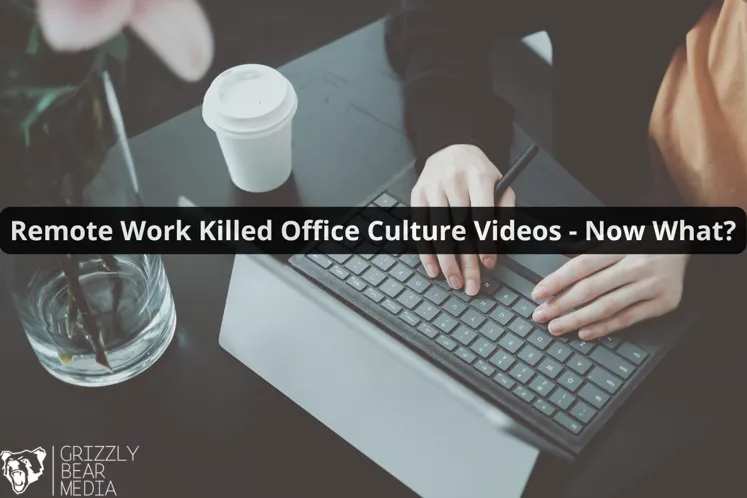Remote work has completely restructured how businesses tell their stories. Those polished office culture videos with teams collaborating around conference tables? They feel as outdated as flip phones now.
We’ve all seen it happen. Companies spent thousands creating sleek workplace videos, only to watch them become irrelevant overnight when everyone started working from kitchen tables.
But your business still needs authentic video content that connects with people. At Grizzly Bear Media, we’ve helped Brisbane businesses manage this change and create content that connects in our new work reality.
In this article, you’ll discover:
- Why traditional office videos no longer work for modern audiences
- The types of video content that perform best in a remote-first world
- Practical strategies for creating engaging business videos
Ready to update your video strategy for the post-pandemic world? Let’s dive in and figure out what works now.
Remote Work’s Impact on the Marketing Environment
The remote work revolution directly influenced marketing strategies like content creation schedules, how we target audiences, and the way brands tell their stories. When everyone started working from home, companies that built their entire video strategy around office spaces had to rethink everything.

The reason this change hit so hard is that remote work made traditional workplace culture videos outdated overnight. Those polished conference room scenes and team brainstorming sessions? They stopped connecting with audiences who were now juggling work calls while their kids played in the background.
However, the companies that adapted early began producing video content that reflected people’s new reality and focused on their teams. Another successful strategy was showcasing real employee experiences instead of staged corporate scenarios.
This included things like:
- Virtual coffee break moments
- Home workspace setup guides
- Remote celebration highlights
- Flexible schedule success stories
When you create content this way, it builds connections with both employees and customers who are living the same experience.
Now that you understand how the marketing landscape has changed, let’s look at what employee engagement means when your whole team works from different suburbs.
Redefining Employee Engagement in a Remote-First World
At a time like this, it’s important to understand and improve employee engagement now that we’re all so far apart. The old ways of checking in with your team don’t work when you can’t just walk over to someone’s desk or catch them in the break room.
We understand how it feels to manage teams you rarely see face-to-face. That’s why you need to get more intentional about staying connected with people.
Here’s where you can do employee engagement surveys to understand what’s working and what isn’t:
Designing Employee Engagement Surveys for a Distributed Workforce
When you’re designing employee engagement surveys, you have to ask questions that get to the heart of what it’s like to work remotely. The reason this matters so much is that remote workers face different challenges than office-based teams. They might feel isolated, struggle with work-life boundaries, or miss out on casual conversations that build relationships.
Besides, getting candid feedback from distributed teams helps you spot problems in the initial stage. One great example of this is discovering that someone feels disconnected from their colleagues, which you can fix with regular video check-ins.
Here’s how to measure employee engagement effectively in remote teams:
- Focus on communication quality over frequency
- Ask about workspace satisfaction and support needs
- Include questions about manager accessibility and feedback
- Measure sense of belonging and team connection
Since you now have the data you need to understand your team’s experience, the next step is to use that information. You’ll build a stronger company culture that keeps people engaged no matter where they work.
How to Build Company Culture to Boost Engaged Employees
A great company culture drives employee engagement by helping people feel connected and valued, leading to a happier, more productive team. The reason this connection is so important is that your happy employees will bring more energy, creativity, and commitment to their work. And that’s what every business owner wants, right?

Even a study shows that 82% of workers say that the ability to work from anywhere has made them happier. Also, 55% say that remote work has reduced their stress levels. These numbers prove that workplace flexibility directly impacts how people feel about their jobs.
But you cannot build a strong culture in remote teams without being deliberate about it. It requires different approaches than traditional office environments. You need to be more intentional about creating shared experiences and celebrating wins together.
For example, weekly team check-ins help maintain connection while monthly virtual celebrations recognise achievements across time zones.
If you invest in these cultural touchpoints, your remote workers will feel connected to the company’s mission and values.
Pro Tip: Focus on consistent communication and recognition rather than trying to replicate in-person culture online. Your remote teams will perform better if they feel heard and valued regularly.
The best way to achieve successful remote work marketing lies in understanding these cultural shifts. When you adapt your content strategy to reflect how work has changed, your videos become tools that build the culture you want and even work for your future marketing strategies.
The Future of Remote Work Marketing
The old playbook is out. So, what does the next generation of remote work marketing look like? In this section, we’ll cover how businesses are reaching their distributed teams and getting results with approaches that would have seemed impossible a few years ago.
Let’s explore what’s working now and what’s coming next to help you adapt your approach.
A New Marketing Focus: The Global Remote Worker
The new target audience for remote work marketing is a worldwide community of professionals who work from anywhere. Suppose your ideal customer used to be someone commuting to an office building in Brisbane. Now they could be working from a beach in Bali or a cafe in Berlin. This shift means your messaging, timing, and channels all need to change, too.
We recommend thinking beyond geographical boundaries when planning your campaigns. The reason you need to do this is simple: your work environment messaging needs to resonate with people in small apartments. It also needs to work for those in large home offices, plus everything in between.
Innovative Strategies for Remote Work Marketing
How do you reach people who never see billboards or office building ads? Well, you meet them where they already spend their time online. That means if your audience scrolls through Instagram during lunch breaks, you need to show up there with content that fits their routine.
And every progressive business is catching on to this reality. Many companies are now diversifying their marketing channels to boost engagement through authentic video content on social media platforms. One company even discovered that their “working from bed” tutorial got more engagement than their polished office tour had ever received.
Building a Community for Remote Professionals
Sometimes the best way to build a community for remote professionals is by creating spaces where they can connect over shared experiences. When you focus on bringing people together rather than selling to them, relationships develop naturally and business follows.
One of our clients shared how they started a monthly virtual coffee chat for remote professionals in their industry. Within six months, they had 300 regular attendees, and 15% of them eventually became paying customers without any hard selling involved.
So that’s a win-win situation that proves community-first marketing works better than traditional sales tactics.
Your Next Steps Forward
Remote work has completely changed how businesses connect with their teams. But the companies getting it right are the ones accepting these changes instead of fighting them. The solutions exist, and they’re working for forward-thinking businesses everywhere.
Throughout this article, we’ve explored how traditional office culture videos became outdated overnight and why employee engagement surveys need fresh approaches for distributed teams. You’ve also learned how successful companies are building authentic cultures remotely and discovered marketing strategies that reach global remote workers effectively.
When you’re ready to change your video content strategy for the remote-first world, we’ll be happy to help you.

Jean Moreau is a talented writer known for crafting engaging captions that resonate with audiences. His creativity enhances social media content effectively.






Leave a Reply